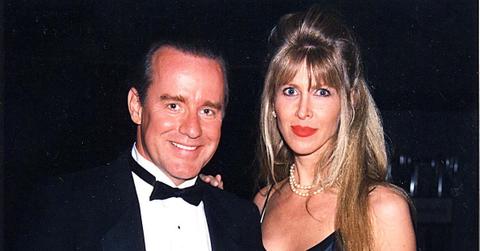'SNL' Comedian Phil Hartman Was Killed in a Murder-Suicide by His Then-Wife
Brynn Omdahl killed her husband, comedian Phil Hartman, in a newsworthy murder-suicide. But why did she kill him?
May 9 2024, Published 4:55 p.m. ET

Content warning: This article mentions domestic violence.
Murder-suicides have a way of capturing media attention unlike any other crime. They tend to involve people who knew each other and may have been intertwined, as well as some level of regret. But of course, one of the most famous and tragic examples was when Brynn Omdahl killed her famous husband, Saturday Night Live alum Phil Hartman, a comedian and actor whose likability was universal.
In the early hours of May 28, 1998, Omdahl shot her husband three times while he was sleeping. After confessing to two friends, she took her own life while police were escorting her children out of her and Hartman’s Encino mansion. But what happened that fateful night and why did Omdahl kill Hartman?

Brynn Omdahl killed Phil Hartman due to “domestic discord” according to authorities.
Hartman was a beloved public figure, whose time in the spotlight cemented his legacy as one of his generation’s greatest comedic minds. After studying and performing with The Groundlings, he went on to work on Saturday Night Live for over a decade before moving on to other projects, such as The Simpsons, NewsRadio, and various films.
However, according to various friends and family, his relationship with Omdahl was often fraught with conflict. They met on a blind date in 1986 and married shortly after in 1987. “They always seemed happy,” Buca di Beppo bartender Todd Red told People after the couple celebrated Omdahl's 40th birthday there. “They always held hands and laughed and seemed like they were having a good time.”

Brynn Omdahl and Phil Hartman's relationship was a mystery to even their closest friends.
But throughout the years, while some friends were oblivious to the conflict in their relationship, others knew there were deeper issues. “When Phil met Brynn, he may well have been at his most vulnerable state in years—his second marriage’s ending had shaken him, and his performing career wasn’t taking off,” author Mike Thomas said in his biography, You Might Remember Me.
“Omdahl was strikingly beautiful, and the affections of a statuesque blonde may have bolstered Hartman’s deflated self-image. But their relationship was bumpy from the get-go.” To understand this, one has to understand Omdahl and Hartman’s personas. Omdahl was a former model and aspiring actress, who may have thought Hartman might be able to lift up her career. She also notoriously struggled with cocaine and alcohol addiction before meeting him.

Hartman, on the other hand, was very closed off when not onstage, a fairly common phenomenon among some of the world’s funniest performers. Steve Small, Hartman’s friend and divorce lawyer for his previous two marriages, shared with People, “Phil was always very open with the public, but at home he retreated inside.”
This was corroborated by Hartman’s second wife, whom he remained friends with after their divorce. Lisa Strain explained, “He would disappear emotionally. Phil’s body would be there, but he’d be in his own world. That passivity made you crazy. And when I’d protest, he’d say, ‘You’re getting in the way of my career, and this is who I am and what it’s going to be like.'”

While his and Strain's divorce was amicable, Hartman knew he wanted to be with Omdahl forever. When his friend and fellow actor, Cassandra Peterson, did not support his marriage to Omdahl, he stopped speaking to Peterson. His career and busy schedule often strained his relationship with Omdahl, who suffered from several insecurities, according to her friends. Add a relapse to their relationship problems, and we have a recipe for disaster.
Brynn Omdahl's return to drugs and alcohol fueled her to murder Phil Hartman.
Omdahl’s friend, songwriter Linda Thompson, told People, “She admitted she’d had a couple of episodes when she’d fallen off the wagon. I remember her saying she didn’t want to be an addict.” So Omdahl checked herself into rehab earlier in 1998 but in the days leading up to her fatal decision, she began using cocaine and drinking more, mixed with a “therapeutic” dose of Zoloft, according to her autopsy and various sources. The combination can cause violent outbursts.

“Sometimes she’d call me and she’d be real hurt,” Omdahl’s friend, Jeannie Petersen, added. “He wouldn’t give her a divorce. For two years she was trying to get it.” But Small was familiar with a pattern in the Hartman household. “She had to get amped up to get his attention, and when she got amped up, he would simply go to sleep. He would withdraw. And in the morning he’d wake up, and everything would be fine.”
But that wasn't the case on May 28, 1998. Hartman was sleeping after Omdahl had a night out with a friend. She was seemingly in good spirits when out, but whatever disagreement she had with Hartman at home, whether about his busy schedule, their kids, her career, or one of the many other strenuous facets of their relationship, led her to escalate the situation.

Guns were kept in the home because of her fear of being alone in a large house so often without Hartman. Now, they were readily available to a woman amped up on cocaine, alcohol, and Zoloft, whose husband wasn’t giving her the attention she desired. And so, she took his life with three bullets as he slept. Whether guilt set in or she panicked because of the police presence, Omdahl then took her own life in the notorious murder-suicide.
If you or someone you know is experiencing domestic violence, call the National Domestic Violence Hotline at 1-800-799-7233.